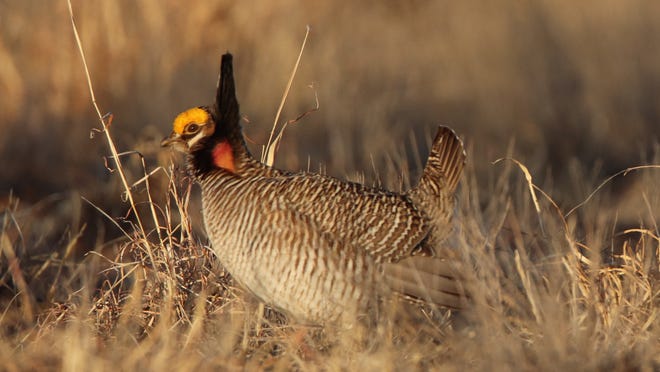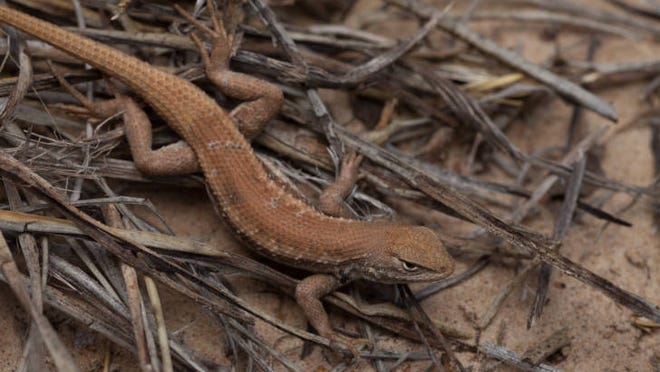
Habitat for the nearly-extinct lesser prairie chicken, known for its unique mating dances in prairies of southeast New Mexico, grew by 7,500 acres as the State of New Mexico purchased land from an energy company in the area.
The New Mexico Department of Game and Fish announced the partnership with NGL Energy Partners to buy the land to conserve it from development for the attempted regrowth of lesser prairie chicken populations.
The bird was thought to once number in the hundreds of thousands across the American West, with a range extending from southern New Mexico into Texas, Colorado, Oklahoma and Kansas.
More:Heinrich bill would unlock federal funds for New Mexico wildlife nearing extinction
Its numbers dropped dramatically in recent years, leading the U.S. Fish and Wildlife Service to consider listing two population areas for protection.
The southern distinct population segment (DPS), encompassing the chicken’s range in New Mexico and Texas was proposed for an endangered designation, which entails the strictest federal restrictions in areas the bird lives or may live, and a northern DPS covering the other three states and northern Texas as threatened – meaning an endangered listing is considered imminent if numbers don’t improve.
In the face of the proposed listing, government agencies and private land owners in the areas sought partnerships to ensure the species was conserved and potentially avoid federal action.
More:Oil and gas, environmentalists debate lesser prairie chicken as federal listing looms
New Mexico’s deal with NGL allowed for the State’s acquisition of Pipkin Ranch, about 40 miles southeast of Fort Sumner using a combination of funds from the company and funds generated by the state through fishing and hunting license sales.
The purchase connects two other existing State-owned properties for the bird, creating more than 10,000 continuous acres dedicated to conservation of grassland wildlife, per the Department’s announcement.
Matthias Sayer with NGL said the company chose to use part of its land holdings in New Mexico for conservation to help support environmental causes and help advance state conservation goals.
Opinion:CEHMM ensures industry and ranching activities continue on the landscape
“Given our land ownership and lease holdings in New Mexico, it was organic and natural that we engage with Game and Fish, and started talking about wildlife conservation not only on our properties and those we manage but across the State,” he said.
Game and Fish Director Mike Sloane said the efforts to conserve the bird and set aside land to do so would help move the state toward its goal of conserving 30 percent of public land by 2030, an initiative announced earlier this summer by Gov. Michelle Lujan Grisham.
“This public-private partnership is an example of the positive work that can occur when we all recognize the value of conservation,” Sloane said. “I am excited to have been a part of this effort and believe that it will stand as an example going forward as we begin to implement the 30 x 30 initiative recently advanced by the governor.”
More:Farmers and ranchers seek to protect property rights amid Lujan Grisham’s conservation order
In announcing the executive order on Aug. 25, Lujan Grisham voiced support for public-private partnership seeing landowners work with state agencies to conserve land and wildlife throughout the state.
“Voluntary practices implemented by managers, including landowners and leaseholder on working land (both private and public) provide opportunities to support broader restoration activities, improve watershed health, create resilience in rural and urban communities, add value to the food chain and food security and contribute to the state’s outdoor recreation and eco-tourism economy,” read the order.
Game Commission Chairwoman Sharon Salazar said the Pipkin Ranch would prove valuable to the species, which requires vast swaths of undisturbed prairie to thrive.
More:New Mexico Gov. Michelle Lujan Grisham aligns State with federal conservation initiative
“Purchasing and maintaining property, such as this ranch, provide a great example of conserving wildlife habitat.” Salazar said. “To the average eye, the Pipkin Ranch might look like rolling grassland with little value; but to the lesser prairie chicken it is a chance for growth – an important conservation stronghold.”
But despite the ongoing efforts, conservationists worried lesser prairie chicken population numbers were slow to recover.
Carlsbad-based conservation non-profit the Center for Excellence (CEHMM), in public comments for the proposed listing contended chicken populations had increased in recent years from 1,125 birds in 2015 to 7,125 in 2020.
More:Lawsuit: US Forest Service failed to protect desert mouse from extinction in Sacramento Mountains
CEHMM facilitates conservation agreements between landowners and government agencies and reported its strategic plan meant restoring 15,000 to 30,000 acres of lesser prairie chicken (LPC) habitat between 2021 and 2025.
Wayne Walker with LPC Conservation, a conservation bank working to purchase land to set aside for habitat from landowners, said to fully restore the bird will take millions of acres.
He questioned if there were enough public funds in government projects to truly, successfully restore the animal to its natural state.
More:Carlsbad landowners chide federal proposal to protect Texas hornshell mussel in New Mexico
“It’s absolutely not enough. This stuff has to start happening at the scale of 10s to hundreds of thousands of acres,” he said. “New Mexico has done an amazing job trying to work on this earlier and harder. They have gotten some money, but it’s just not enough.”
He said he expects the animal to be listed under the Endangered Species Act because land sales are not offered at “market-based” rates which means less landowners sign contracts and less land is conserved.
“We’ve got to do big, strategic stuff to save hundreds of thousands of acres to turn this bird around. Everybody gets a gold star for trying, but nothing gets done,” Walker said. We know from the population numbers and habitat that its worse.
“Because we don’t have these performance standards, it’s hard to track what’s working. These old conservation standards were done with the best intentions. But now there’s been all this time the standards need to be upgraded.”
Adrian Hedden can be reached at 575-618-7631, achedden@currentargus.com or @AdrianHedden on Twitter.







